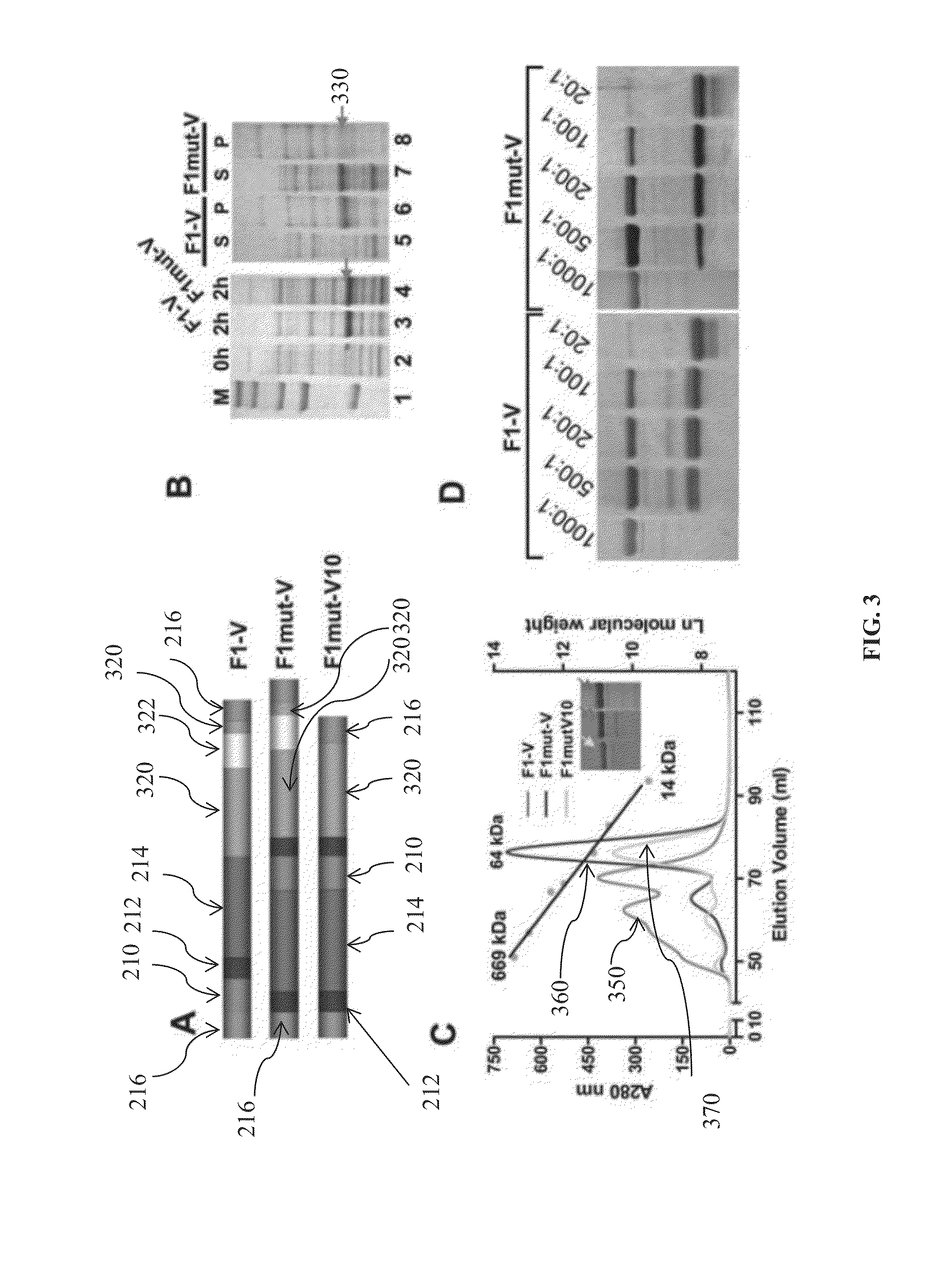Mutated and bacteriophage t4 nanoparticle arrayed f1-v immunogens from yersinia pestis as next generation plague vaccines
a technology of yersinia pestis and mutated immunogens, which is applied in the field of mutated immunogens from yersinia pestis and antigen carriers, can solve the problems of no fda approved vaccine against plague, no evidence and a serious threat to the use of yersinia pestis as a bioterror agen
- Summary
- Abstract
- Description
- Claims
- Application Information
AI Technical Summary
Benefits of technology
Problems solved by technology
Method used
Image
Examples
example 1
Designing a Soluble Monomeric F1 Mutant
[0115]Panel A of FIG. 2 is a schematic of native F1, F1mut1, and F1mut2 recombinant constructs. Shade 210 shows a coding sequence of a donor β-strand of F1. Shade 212 shows a coding sequence of a T cell epitope region. Shade 214 shows a rest of the F1 coding sequence. Native F1 has one hexa-histidine tag of SEQ ID NO. 2 shown in shade 216 at the NH2-terminus of F1, whereas F1mut1 and F1mut2 have two hexa-histidine tags of SEQ ID NO. 2 shown in shade 216, one at the NH2-terminus of F1 and another at the COOH-terminus of F1. The numbers above the shades 210, 212 and 216 correspond to the positions of amino acid residues of F1, for example, number 1 corresponds to the first NH2-terminal amino acid residue of F1, number 14 corresponds to the 14th NH2-terminal amino acid residue of F1, and number 21 corresponds to the 21th NH2-terminal amino acid residue of F1.
[0116]Panel B of FIG. 2 shows an expression and solubility analysis of the recombinant pro...
example 2
Restoring the Potential T Cell Epitopes of F1 Mutant
[0120]In this example, a bioinformatics approach is used to determine if shifting of the NH2-terminal β-strand of F1 to the COOH-terminus of F1 disrupts the NH2-terminal epitopes of F1. The aa residues 7 to 20 are reported to contain a mouse H-2-IAd restricted CD4+ T cell epitope.
[0121]CD8+ and CD4+ T cell epitopes are predicted using MetaMHC (http: / / www.biokdd.fudan.edu.cn / Service / MetaMHC.html) with default values. Peptides identified as positive by at least one ensemble predictor approach are considered to be potential CD8+ T cell epitopes or potential CD4+ T cell epitopes.
[0122]Predicted CD8+ T cell epitopes are shown in Table 1 below. Highlighted cells indicate high ranking scores that predict a potential CD8+ T cell epitope. Predicted CD4+ T cell epitopes are shown in Table 2 below.
TABLE 1The predicted CD8+ T cell epitopes:Methods used for epitope predictionNetMHCAllelePositionpeptideANNSMMNetMHCPanConsensusPMAvgTanhHLA138-146...
example 3
Construction of Mutated F1-V Immunogens
[0124]Panel A of FIG. 3 shows a set of schematics of construction of recombinant proteins encompassing native F1-V, F1mut-V and F1mut-V10, respectively. Native fusion protein F1-V is constructed by fusing native F1 to the NH2-terminus of native V. Shade 320 represents the coding sequence of V antigen. Shade 322 represents the coding sequence of putative immunomodulatory sequence that is a part of the coding sequence of V antigen. Rest of the shades represent the same as shown in FIG. 2, wherein shade 210 shows a coding sequence of a donor β-strand of F1, shade 212 shows a coding sequence of a T cell epitope region, shade 214 shows a rest of the F1 coding sequence, and shade 216 shows a one hexa-histidine tag of SEQ ID NO. 2.
[0125]Fusion of F1mut2 to V can generate a bivalent plague vaccine. Consequently, in this example, a mutated F1-V fusion protein (F1mut-V) is produced by fusing F1mut2 to the NH2-terminus of V with a two amino acid linker (S...
PUM
| Property | Measurement | Unit |
|---|---|---|
| Acidity | aaaaa | aaaaa |
| Immunogenicity | aaaaa | aaaaa |
Abstract
Description
Claims
Application Information
 Login to View More
Login to View More - R&D
- Intellectual Property
- Life Sciences
- Materials
- Tech Scout
- Unparalleled Data Quality
- Higher Quality Content
- 60% Fewer Hallucinations
Browse by: Latest US Patents, China's latest patents, Technical Efficacy Thesaurus, Application Domain, Technology Topic, Popular Technical Reports.
© 2025 PatSnap. All rights reserved.Legal|Privacy policy|Modern Slavery Act Transparency Statement|Sitemap|About US| Contact US: help@patsnap.com



